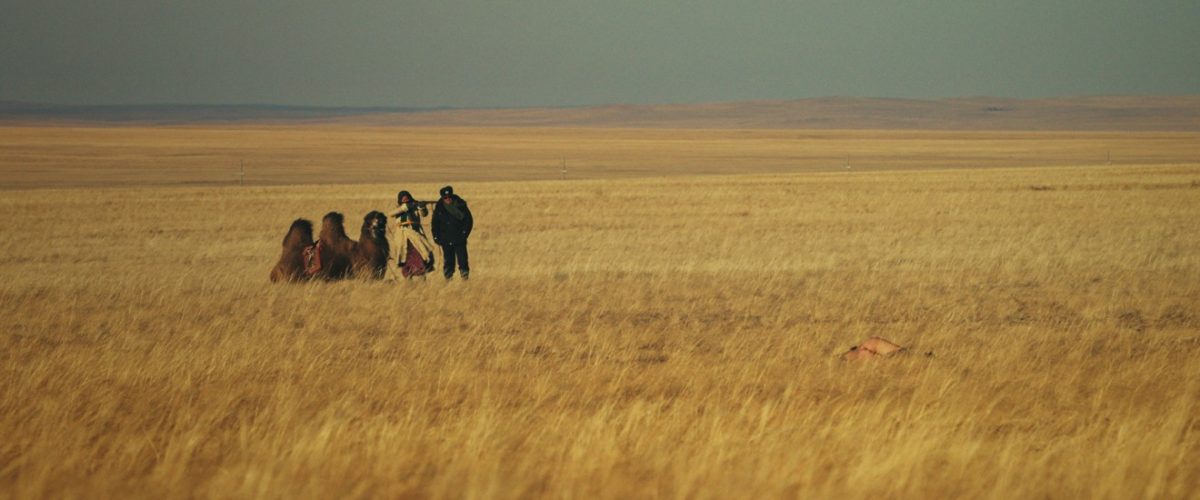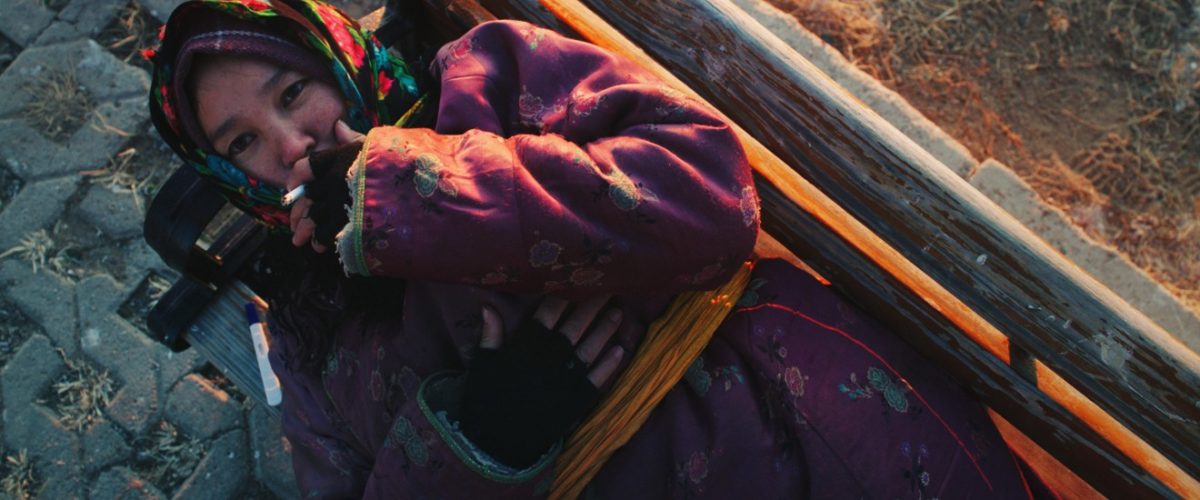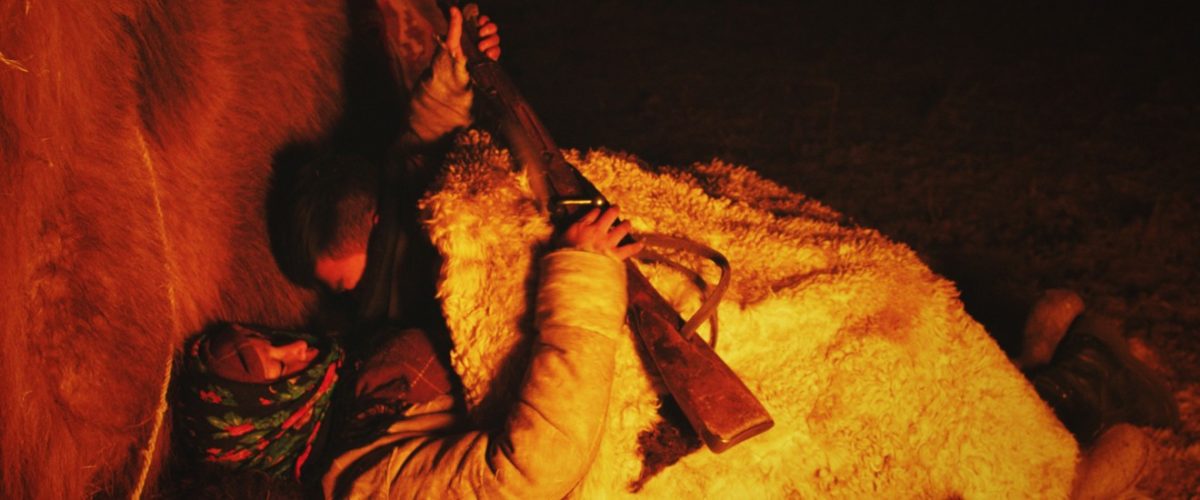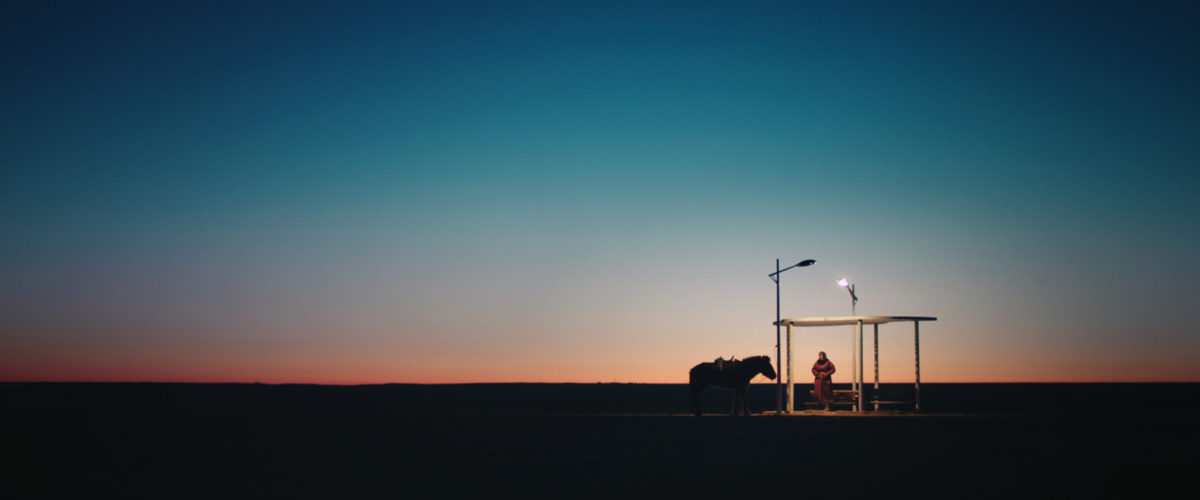Right from the start, Wang Quan’an’s Öndög (2019) throws us into the Mongolian landscape, although at first we as spectators are not aware of it. We find ourselves in medias res, not knowing how to position ourselves within the space. The film opens with a black screen, its soundtrack filled only with the voices of men talking amongst themselves. Our disorientation ends momentarily when lights are turned on, a car’s headlights apparently, only for us to discover that we are still lost in the setting. We move with the car, its headlights capturing fragments of the surroundings, temporarily illuminating a herd of wild horses and finally coming to a halt, fixating the contours of a human body. This might read like the beginning of a murder mystery, but it is not; Öndög solves its crime off screen. Instead Wang Quan’an directs our attention to how human and non-human figures move within a landscape.
Before digging into the specifics of Öndög, it is important to note that our relation to space changed significantly at the time cinema was invented, mainly through the influence of colonialism and the rise of tourism facilitated by new and faster ways of travelling. Still, tourism was not for everyone. Travel films were a way for the less wealthy to see what was otherwise only accessible to them in the still form of painting or photography, and even to those media their access was limited. A widespread fascination for the natural world in motion quickly made travel films popular. The famous amusement park attractions ‘Hale’s Tours of the World’ for example, with movies like The Georgetown Loop (1903), were designed to simulate a railway journey, showing films that were shot from the front of a moving vehicle (just as the camera is attached to the moving vehicle in the opening shot of Öndög). Hale’s Tours of the World provided its ‘passengers’ with a faithful representation of what they would see if they were to take a real train ride, looking out of its windows, observing both landscape and city. In Landscape and Film, Marin Lefebvre noted that “It is almost as if the décor had been set first and the cinema was simply waiting for the players to arrive and turn it into the setting for some unfolding drama.” Counter to the history of most of western art, where narrative came first and space emancipated itself from it, space in cinema was the starting point from which the action emerged.
Film had the capacity to show audiences what they would otherwise not be able to see, including exotic lands, peoples and events. Hollywood became the dominant locus for the representation of the world ‘abroad’ to Western audiences, shaping our conceptions of places we could not visit and at the same time influencing the way we would perceive them upon encountering them. In this way, the cinematic landscape, as part of the cultural product called ‘cinema’, is mediated by power relations, which create a specific iconography of space. When we look at nature, we frame it, and this mental activity is made permanent in cinema; nature becomes landscape. Most obvious in this case is the Hollywood western, which uses the characteristic desert wastelands of the American frontier as an allegorical space first to mythologize nation building and later to critique modern society. The more westerns were made, the more they became a significant part of what we refer to as culture, namely our collective interpretation of our environment. In cinema, there is no longer any real ‘absolute’ landscape anymore, only the myth we have constructed of it.
Although landscape in cinema is at the moment not a genre as such, as it still is in other visual media, it is however omnipresent. Landscape is a central element in the formation of cinematic space. It positions a film within a particular geographical scale and historical context but is at the same time the freest element of cinema, the least burdened with narrative tasks and the most flexible in conveying moods, emotional states and spiritual experiences. Chinese director Wang Quan’an is acutely aware of this. His latest film Öndög zooms in on the inhabitants of the Mongolian steppe while concomitantly studying the landscape’s non-narrative qualities. Wang shapes his characters through their interaction with the landscape and at the same time shapes our understanding of the landscape by how the characters are positioned in the space they occupy. Personal, social and cultural concepts add meaning to a space, making it not only relevant as aesthetic entity, but also as a political or cultural one. Landscapes do not exist independently of human investment towards space, which distinguishes them from nature, as our interaction with it produces the frame. Nature provides the area in which the drama can unfold, and by actively involving ourselves in it, gets turned into a space of action, thereby creating a landscape that has been carefully outlined.

After the opening credits, we see the setting of the scene described above in broad daylight. There is no surprise here: landscape is often established in a master shot or establishing shot and these often rely on icons and stereotypes of place to establish a cognitive map of the narrative’s geographic location. The Mongolian steppe, with its never-ending yellowed grasslands, contrasted with a blue shifting sky, seems beautifully desolate. The camera slowly examines the field, tracking from left to right. It takes six minutes before we see the first characters, a group of policemen and a woman, Dinosaur, who helps them scare away a wolfIt is remarkable however that the first human we see in the film is a deceased one, and that we first see animals, rather than people, inhabiting the space.. (Talk about a woman taking the lead!) The youngest of the policemen, Norovsambuu, will come to occupy a central role in the film as he is burdened with the task of protecting the corpse from wolves overnight, with the help of Dinosaur, the only one who owns a gun. Human figures now occupy the space but we still do not get a clear look at them. The long shot makes it hard, or one could even say impossible, to make out any facial traits. These images are not so much about the human figure in se, as they are about its interrelation with the landscape.
On first impression, Wang seemingly falls into the trap of exoticism, seducing the viewer to feel nostalgic about a rustic rural lifestyle. True, the admiration for nature, animals and husbandry is omnipresent and the film deploys certain slow cinema conventions like wide, static long shots and the disappearance of human figures in the landscape. However, Öndög goes beyond exoticism by using the setting as a rhetorical device to discuss exactly these notions of the treatment of a cultural particularity as fixed. Wang shows us a Mongolia different from the Western stereotypes associated with it, which frame it as a place forgotten by time and untouched by progress; this idea was mainly created by the Romantic European travelers that portrayed Mongolia as a country of nomads roaming over unbounded territory. When Wang shows us a traditional yurt, he contrasts it by adding a satellite dish on top of it. The image of the yurt is a tool to indicate the heritage of the Mongolian identity; as such, it more often than not becomes a cultural ornament used to create a fictional national identity that displays the uniqueness of the Mongolian inhabitant, while at the same time enabling her objectification as an outsider. That is why the inclusion of the satellite dish is so remarkable here: Dinosaur is not separated from the modern world, but part of it. Mongolia is not depicted as essentially a country of nomads, unspoiled by modernity, a myth that has made Mongolia a top exotic destination for travelers, or culture collectors, longing for escape. Even the ‘Lonely Planet’ series narrates this desire as it promises tourists not only a spatial escape, but also the chance to go back in time, showing not another country but a whole other century, somewhere perpetually alien yet romantically exotic. This portrayal of Mongolia serves the need for an imagined Other.

Öndög plays with Mongolian stereotypes by adding traces of modern life to the screen, creating humorous dichotomies. The first time we get a clear full-frontal shot of Dinosaur’s face (or actually the first full-frontal shot at all) is when she is inside the yurt, smoking a cigarette, an image that contrast the widespread idea of nomads as untamed men. Later, when Dinosaur takes a pregnancy test outside, she is using a piece of technology that is a homogeneous feature of globalization in the middle of nowhere, again contradicting the stereotype. There’s also the scene where Norovsambuu uses his smartphone as a music player in the desolate Mongolian steppe, surrounded by nothing but nature, resulting in a humorous junction of the impressionistic, painting-like setting with the modern world. The first song we hear is a traditional Mongolian one but the music session ends with Elvis’ Love Me Tender’ playing, as Norovsambuu sways his lit mobile phone, reminiscent of a modern concert-goer. Wang shifts here between diegetic and non-diegetic sound, confusing the viewer whether or not the music is present in the story or used to set the mood. Norovsambuu is not, as none of the characters are, overwhelmed by the sublime terrain of the Mongolian landscape. Instead the characters domesticate the scene. Öndög does not present a vision of Mongolia to the world, but a Mongolian vision of the world: meaning that there is an inversion of the subject position from the dominant perspective of the (mainly) Western audience to that of the (marginal) Mongolian character.
Öndög makes no explicit references to Mongolia: the viewer has to deduce the location via secondary information (or because the internet says so). In investigating landscape in film, one is considering landscape as more than mere spatial background that necessarily accompanies the depiction of actions and events. However, landscape is not solely a representation of nature. There is always a human presence embedded in the framing. Our perception of nature is always pervaded by our ideas and memories of it. We do not look at it purely objective, as if from a distance, but we see it instead as an inhabited environment: both symbolically, in relation to the narrative, and in site-specifically, linked to our preconceptions about the location. Wang uses beautiful compositions to show his respect for the landscape that both humans and animals inhabit, often framing them in the same way: observed from a distance and with minimal dialogue. At certain moments, the figures even seem to dissolve into the landscape, fusing with the steppe. Just as both Dinosaur’s and Norovsambuu’s life gets turned upside down, so does the landscape, turning from solitary and ordered to vibrant. The sex scene between Dinosaur and Norovsambuu operates as a narrative and visual turning pointFurthermore, the sex scene has a ritualistic layer to it: as the camera seems to blur the distinction between animal and human, blending camel (they have sex right in front of it) and the couple, camouflaged under an enormous pile of fabric.. After it, Dinosaur opens up, even welcoming new life, while we see Norovsambuu entering adulthood. The landscape is represented more freely with untamed horses running wildly through the frame, in contrast to the wolves that had to be eliminated at the beginning of the movie. The recurring motif of open doors (or opportunities) is set in opposition with the voyeuristic framing of Dinosaur early on, where she is repeatedly shown inside, shot from outside through her window, as if she is locked up, feeling stuck. This feeling of entrapment gets even more intense because it is alternated with shots of the endless landscape.

Landscape in film can be a spectacle—something beautiful and visually pleasant, yet imprinted with power relations creating a problematic balance between who is gazing and what or who is being gazed upon. Wang counters exoticism by playing with the power relations embedded in cinematic landscapes, as he exposes the preconceptions of his viewers and denounces them by showing how modernity creeps in, even in the most remote corners of the world. We see the herding of sheep with factories looming in the background. There is a bus stop in the middle of nowhere, where Dinosaur waits for the result of her pregnancy test and enjoys a smoke. The epic grandeur of the Mongolian plateau is ever-present but there is always an added layer to it—traces of modernity, serving as (humorous) contrast. Yet, the majority of Mongolia can hardly be described as nomadic anymore. While Mongolian nomadic identity has been appropriated and perpetuated in Western Orientalist discourse, the myth is also a Mongolian-produced self-fiction: a fiction that both glorifies and blasphemes nomadic identity. In Öndög however, Mongolia is not solely represented as exotic, marvelous, or picturesque. Hereby Wang de-territorializes the narrative, away from a familiar and codified exoticism. Rather than being a “pure” culture untainted by any foreign influence, the Mongolian identity is here shown as constructed in relation to its global relations, introducing modernity to all corners of society. Öndög does not obscure the fact that the landscape is impressive or that Dinosaur lives in a yurt; Quan’an however denounces the poverty in only showing Mongolia as a static world and adds traces of modern life to depict Mongolia in a dynamic state, adjusting to a modern world while keeping its particularity. In Öndög, there is no need to choose between tradition or modernity.
